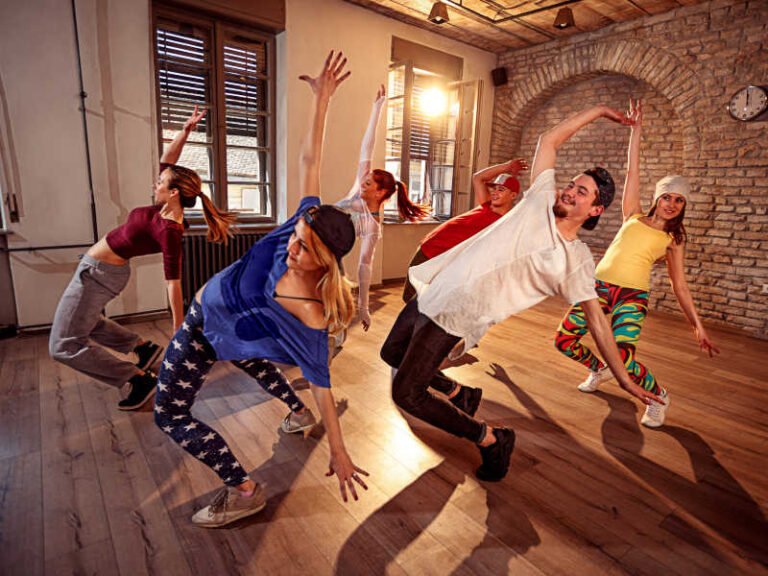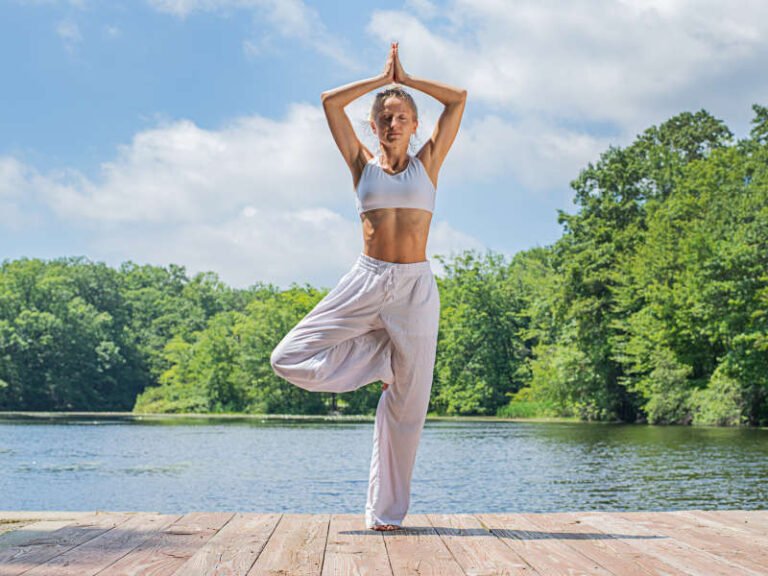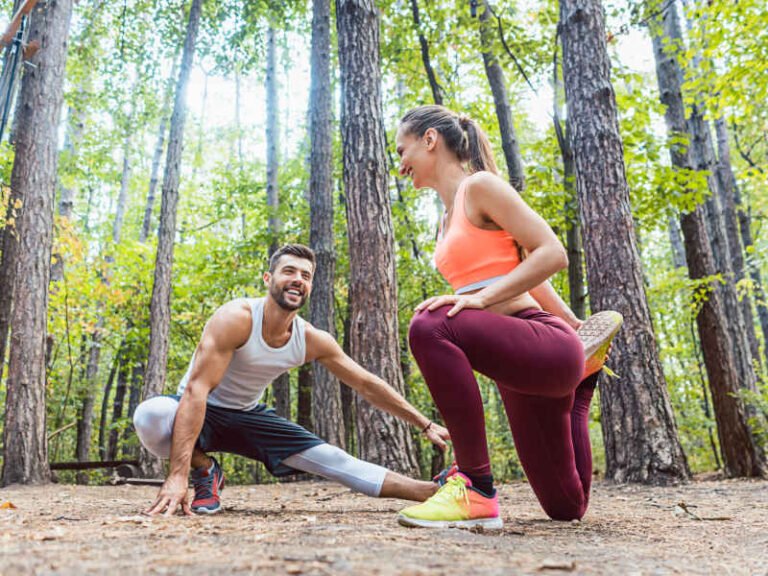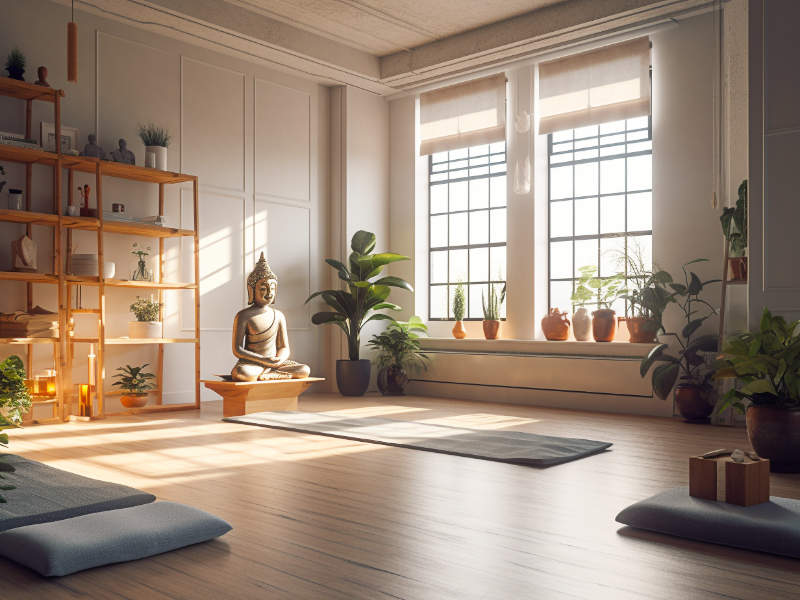
Discover the Power of Yoga: A Novice’s Guide to Embracing Yoga
Imagine standing at the threshold of a serene lake, bathed in the gentle warmth of morning sunshine, a harmonious blend of inner peace and invigorating energy resonating within you.
This imagery encapsulates the essence of yoga, a timeless practice that reaches far beyond the physical realm, into a transformative process that nourishes your whole-being.
“Yoga is the journey of the self, through the self, to the self.”
These words, from the sacred yogic text, The Bhagavad Gita, beautifully summarize the empowering transformation that embracing yoga can bring to your life.
In this guide, we extend a warm invitation to delve into the vast landscape of yoga.
Whether you’re a complete beginner or someone wishing to deepen their practice, this guide promises insightful revelations that will illuminate your path.
We’ll begin by unraveling yoga’s origins and core essence, shedding light on its rejuvenating power for both physical health and mental well-being.
Additionally, we will debunk common misconceptions that can act as roadblocks for beginners, encouraging a mindset shift towards understanding yoga as a rewarding practice accessible to all.
Highlighting this exploration is an introduction to “Pranayama,” the art of breathwork in yoga.
As the crucial bridge connecting our mind, body, and spirit, we’ll introduce you to basic pranayama techniques that can elevate your daily practice.
Moreover, we’ll journey together through essential yoga poses, building personal routines, and unearthing the profound mind-body connection inherent in yoga.
Our aim is to empower you, equipping you with knowledge and confidence to seamlessly integrate yoga into your daily life.
This exploration invites you to discover yoga’s transformative power, tapping into the wellspring of harmony and vitality within.
In the realm of yoga, you’re not simply a beginner; you’re an explorer, on the brink of a profound process of self-discovery and wellness.
Let’s step into a practice that will transform your world from the inside out.
Ready to Step Into Your Power?
Unlock the clarity & wisdom that illuminates your path to a conscious, radiant life
Join the Wholebeing Newsletter Today!
By signing up, you agree to receive our well-being emails, special offers, and agree to the Privacy Policy. You can unsubscribe at any time.
Understanding Yoga
At its core, yoga is more than a physical discipline—it’s a holistic practice encompassing mind, body, and spirit.
Originating from the ancient Sanskrit word “Yuj,” yoga translates to “union” or “to yoke.”
It signifies the harmonious integration of the mind and body, cultivating a sense of unity within oneself and with the world around.
Yoga’s roots stretch back thousands of years, nestled in the cradle of ancient Indian philosophy.
As a practice deeply embedded in spirituality, it was originally used to prepare the body for meditation, cultivating physical resilience and mental tranquility.
The rich tapestry of yoga we see today has been influenced by several traditions, including Buddhism and Hinduism, evolving into various styles and practices that cater to diverse needs and preferences.
But why should you incorporate yoga into your daily routine?
The simple answer lies in its holistic approach to well-being.
By engaging with yoga, you’re not just signing up for a physical workout, but an enriching experience that nourishes your mental, emotional, and spiritual facets.
Physically, yoga enhances strength, flexibility, and balance, aiding in overall fitness.
But the magic of yoga extends far beyond the mat—its true power is revealed in the profound impact on mental well-being.
Through mindful movements and deep, conscious breathing, yoga fosters stress reduction and emotional balance.
It’s a space where you can cultivate inner peace, grounding yourself amidst the daily whirlwind of life.
But perhaps the most beautiful gift of yoga is its ability to foster a deep, resonant connection between the mind and body.
In a world that often feels fragmented, yoga brings unity.
It invites you to engage fully with the present moment, to listen to your body, and to move with intention.
In this light, yoga ascends beyond a mere practice—it transforms into a lifestyle, an exploration of self-discovery—where every time you step onto your mat, you’re moving towards a more balanced, harmonious, and vibrant version of you.
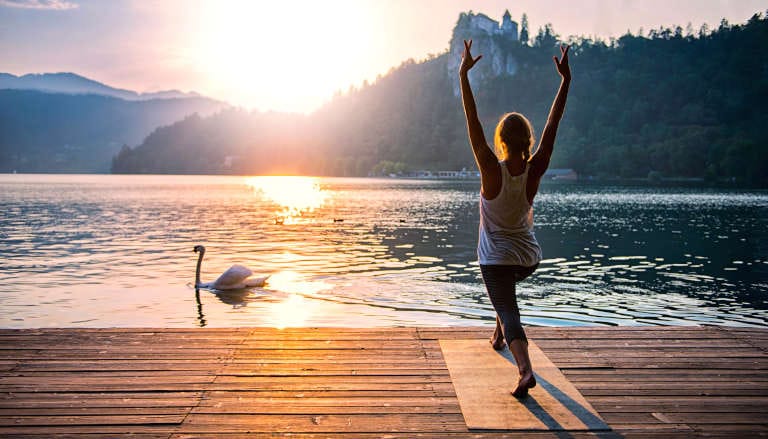
The Power of Yoga
Yoga’s Physical Triad: Strength, Flexibility, Posture
When we think of yoga, images of graceful poses, focused expressions, and serene environments often come to mind.
Yet, these outward images only scrape the surface of the profound potential that yoga offers.
One of the most tangible benefits of yoga is its transformative impact on physical health—specifically in terms of strength, flexibility, and posture.
Let’s delve into each of these areas to uncover the unique power of yoga.
Strength: Unlike traditional gym workouts that isolate specific muscle groups, yoga is a full-body practice.
Every pose you enter into challenges various muscles to support and balance your body weight.
Take the Warrior II pose, for example, where you’re simultaneously strengthening your legs, arms, and core as you hold yourself in the stance.
As you flow from one pose to another, yoga encourages dynamic strength development (which also aligns with functional training principles), enhancing overall muscular endurance and stability.
Flexibility: Yoga and flexibility are often mentioned hand in hand, and for good reason. The myriad of yoga poses—from gentle twists to deep forward bends—help stretch and lengthen your muscles.
Over time, this improves overall flexibility and range of motion.
Not naturally flexible?
That’s not a problem.
Yoga is not about touching your toes; it’s about creating space where you were once stuck.
It’s a gradual journey, and with consistent practice, you’ll notice a progressive loosening in your body, opening up areas you didn’t even realize were tense.
Posture: The modern lifestyle often finds us hunched over a desk, leading to poor posture that can trigger back and neck pain, headaches, and even breathing difficulties.
This is where yoga comes in, offering an effective solution to counteract these issues.
Many yoga poses promote spinal alignment, encouraging you to open your chest, pull back your shoulders, and maintain a neutral spine.
Regular practice can enhance your body awareness, making you more conscious of your posture throughout the day, whether you’re standing, sitting, or moving around.
In essence, the physical power of yoga lies not just in its ability to sculpt our bodies, but in the profound connection it nurtures between our physical actions and our mental state.
It invites us to discover strength we didn’t know we had, and flexibility we didn’t think we could achieve.
Harmonizing the Mind: Yoga’s Impact on Mental Health
Yoga is more than a physical exercise; it’s a holistic practice that positively influences our mental health.
The rhythmic flow of breath and movement in yoga quiets the mind, fostering a profound sense of inner peace and clarity.
Regular yoga practice assists in stress reduction, a common challenge in today’s fast-paced society.
By activating our body’s relaxation response through gentle stretches and mindful breathing, yoga can help to reduce the production of stress hormones, promoting a feeling of calm and relaxation.
Beyond stress relief, yoga significantly improves our focus and attention.
The mindful nature of yoga encourages us to stay present and focused on our breath and movements.
Over time, this cultivates an improved ability to concentrate in our daily lives, enhancing productivity and overall cognitive function.
Furthermore, yoga supports emotional balance.
By releasing accumulated tension and restoring balance to our nervous system, yoga fosters a stable emotional state.
It encourages the expression and release of suppressed emotions, leading to improved mood and emotional well-being.
Unifying Mind & Body: Yoga’s Path to Inner Connection
At its core, yoga is a practice of presence and mindfulness. It compels us to slow down, to pay attention, and to truly connect with ourselves.
This connection isn’t just about feeling more in tune with our bodies, but it’s also about fostering a deeper connection between our mind and body.
When we practice yoga, we become more aware of our thoughts, emotions, and physical sensations.
This heightened sense of awareness allows us to observe our habitual thought patterns and to understand how they influence our emotions and behaviors.
Moreover, yoga strengthens the connection between our minds and bodies.
As we move through different postures, we learn to listen to our bodies’ signals and to respond with care and kindness.
This, in turn, fosters a sense of self-compassion and acceptance, leading to improved mental and emotional health.
Ultimately, the power of yoga lies in its ability to cultivate mindfulness and to create a harmonious connection between our bodies and minds.
This connection is key to living a more conscious, balanced, and fulfilling life.
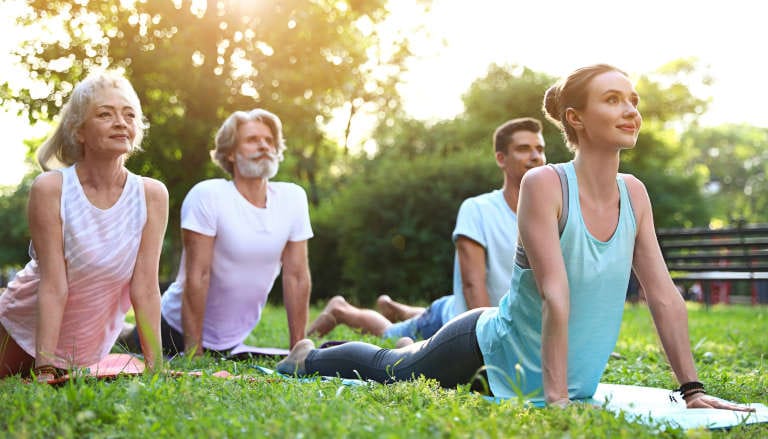
Clearing the Path for Your Yoga Journey
Yoga is a practice shrouded in mystique, and unfortunately, this often leads to misconceptions that can discourage beginners.
Let’s set the record straight and pave the way for your transformative exploration.
One common belief is that you need to be extremely flexible or be of a certain age to practice yoga.
However, the truth couldn’t be more different.
Yoga is about the individual journey, not the destination.
You do not need to be a contortionist or in your 20s to start your practice.
Yoga is a universal discipline, suitable and adaptable for all ages and levels of flexibility.
Stepping onto the yoga mat for the first time can feel intimidating, especially when you’re bombarded by myths and misconceptions.
Changing our mindset about yoga is the first step in truly embracing the practice.
Yoga is not a competition; it’s a personal journey of self-discovery and self-improvement.
As you begin your practice, remember to be patient with yourself, focus on your own progress, and most importantly, enjoy the process.

Mastering the Breath: Pranayama in Yoga Practice
In the ancient practice of yoga, the breath, known as ‘prana,’ is viewed as the life force, the vital energy that fuels our existence.
Breath control, or ‘Pranayama,’ is a fundamental element of yoga that brings about a sense of calm, focus, and balance.
Understanding Pranayama
Pranayama is a Sanskrit word where ‘Prana’ signifies life force, and ‘ayama’ implies control or mastery.
It’s much more than mere breathing exercises.
Pranayama is a bridge between our physical and mental states, acting as a pathway to deeper awareness and mindfulness.
The Connection Between Breath & Energy
In yoga, the breath is seen as the carrier of energy.
When we practice pranayama, we learn to control our breath, and in doing so, we harness and guide our life force.
This harmonizing of breath and energy allows us to attain a balanced state, encouraging better physical health, mental clarity, and emotional tranquility.
Pranayama for Beginners
For those new to yoga, here are a few simple pranayama techniques to begin with:
1. Dirga Pranayama (Three-Part Breath): This technique encourages you to take deep, full breaths, which can help reduce stress and promote relaxation.
2. Nadi Shodhana (Alternate Nostril Breathing): This practice balances the left and right sides of the brain and is an excellent technique for calming the mind.
3. Ujjayi Pranayama (Victorious Breath or Ocean Breath): This technique involves breathing deeply in and out through the nose, creating a soothing ocean-like sound. It helps to focus the mind and extend the length of the breath.
Remember, pranayama, like any other aspect of yoga, is a practice.
Begin with a few minutes each day, gradually extending your practice as your comfort and familiarity increase.
Breath is the link between our body and mind, and learning to control it is the first step towards harmonizing the two, unlocking the full power of yoga.
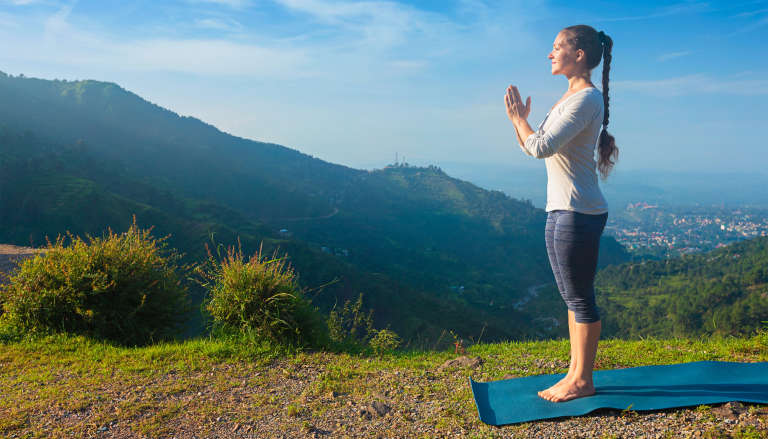
Starting Right: Essential Yoga Poses for Beginners
As a newcomer to yoga, familiarizing yourself with some key poses will lay a strong foundation for your practice.
These foundational postures, also known as ‘asanas,’ are designed to help you develop balance, flexibility, and strength.
Understanding Yoga Poses
Let’s delve deeper into some of the beginner-friendly poses, outlining their benefits, precautions, and step-by-step instructions for practicing them safely.
1. Mountain Pose (Tadasana): Tadasana forms the basis of all standing postures and is excellent for improving balance, posture, and self-awareness.
To perform Tadasana:
- Stand erect, ensuring your feet are hip-width apart.
- Distribute your weight evenly across both feet.
- Lengthen your spine, drawing your abdomen in and up.
- Allow your arms to hang naturally, with palms facing forwards.
- Gently draw your shoulder blades towards each other, opening your chest.
- Keep your chin parallel to the ground, aligning your head above the spine.
2. Downward-Facing Dog (Adho Mukha Svanasana): A cornerstone of many yoga routines, this pose strengthens the upper body and extends the back and hamstrings.
To perform Downward-Facing Dog:
- Begin with your hands and knees on the mat, forming a position similar to a tabletop.
- Set your hands slightly forward of your shoulders, spreading your fingers wide.
- Press your palms firmly into the mat as you lift your hips back and up, coming onto your toes.
- Gradually straighten your legs, pushing your heels towards the floor. It’s perfectly normal if your heels don’t currently touch the mat.
- Relax your head between your arms, gazing towards your legs.
3. Warrior II (Virabhadrasana II): A powerful pose, Virabhadrasana II enhances stamina, concentration, and balance while strengthening the legs and core.
To perform Warrior II:
- Transitioning from Mountain Pose, space your feet approximately 4 feet apart.
- Turn your right foot out to a 90-degree angle and your left foot slightly inward.
- Lift your arms until they’re parallel to the floor, palms facing down.
- Bend your right knee until it’s directly above your right ankle, your shin perpendicular to the floor.
- Rotate your head towards the right, casting your gaze along your right side stretch.
4. Child’s Pose (Balasana): Balasana is a calming, restorative pose that gently stretches the hips, thighs, and spine.
To perform Child’s Pose:
- Initiate the pose by positioning yourself on your hands and knees on the mat.
- Align your big toes side by side and widen your knees until they’re hip width apart.
- Exhale and lower your hips towards the heels, resting the torso between your thighs.
- Extend your arms in front of you, palms down, or let them rest alongside your body, palms up.
- Allow your forehead to gently find rest on the comfort of the mat.
5. Tree Pose (Vrksasana): Vrksasana is a standing balance pose that hones concentration and balance while stretching the inner thighs and strengthening the calves and ankles.
To perform Tree Pose:
- Start in Mountain Pose.
- Shift your weight onto your right foot, rooting it down into the ground.
- Bend your left knee and place the sole of your left foot on your inner right thigh or calf, avoiding the knee.
- Press your foot and leg together for stability.
- Bring your hands together in prayer position at your heart or extend them overhead, keeping your gaze steady.
Adapting Poses to Your Needs
Remember, yoga is a personal journey, and every body is unique.
Don’t strive to look like the pictures or compare yourself to others.
It’s essential to listen to your body and adapt the poses to suit your needs.
Use props such as blocks, bolsters, and straps to support your practice and make the poses accessible.
If a pose doesn’t feel right, modify it or come out of it.
The goal is not to perform the perfect pose but to connect with yourself and feel good in your body.
Yoga is about self-discovery and self-acceptance, so be patient with yourself.
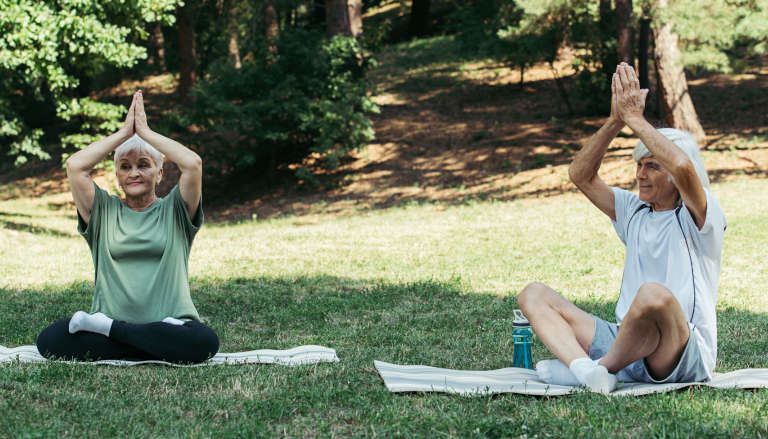
Embarking on Your Personal Yoga Journey
Entering the world of yoga, you might be curious about how to establish your own practice.
Fear not, yoga is designed to weave seamlessly into the fabric of your everyday life, whether through asanas, pranayama, or meditation.
Cultivating a Daily Yoga Practice
Yoga is a flexible practice—both literally and metaphorically.
Begin by setting aside a specific time each day for practicing yoga.
This could be a morning session to awaken your senses and set a positive tone for the day, or an evening session to unwind and release the day’s stress.
This daily yoga practice doesn’t have to be asana-focused every day; it can also involve pranayama (breathwork), meditation, or reading about yoga philosophy.
Aim for at least 15 minutes a day and gradually increase as you become more comfortable and your proficiency improves.
Optimal Duration & Frequency for Asana Practice
While daily mindfulness, breathwork or meditation can be beneficial, your asana (physical poses) practice might not be daily, and that’s okay.
The duration and frequency of your asana practice will depend on your personal preferences and schedule.
Ideally, a beginner should aim for 2-3 asana sessions per week, each lasting 20-30 minutes.
As your strength, flexibility, and endurance improve, feel free to gradually increase the duration and frequency of your asana practice.
Creating a Serene Space for Yoga
Establishing an environment conducive to yoga is as important as the practice itself.
Designate a specific area in your home for yoga—a space that is clean, calm, and free from distractions.
Consider enhancing the ambiance with soft lighting, scented candles, and tranquil meditative music.
Remember, your yoga routine should serve you and your needs.
Stay flexible and allow yourself the freedom to adapt your practice as you grow and evolve.
After all, yoga is your unique journey, it is not a destination.
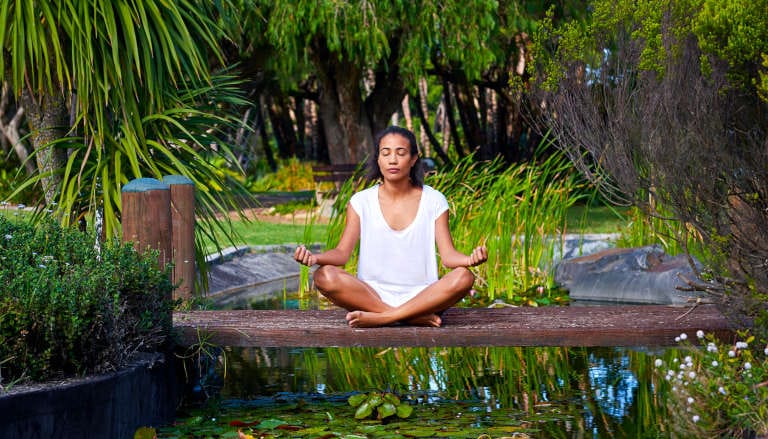
Delving into the Mind-Body Connection in Yoga
The magic of yoga lies in its power to bridge the gap between the physical and the mental, inviting a sense of unity and wholeness.
A key component in this harmonious blend is mindfulness – a state of being wholly present and attuned to the current moment.
The Role of Mindfulness in Yoga
Mindfulness acts as the golden thread that weaves together the body, mind, and spirit.
It urges us to fully immerse ourselves in the rhythm of our breath, the flow of our movements, and the quiet stillness within each pose.
It’s not just about achieving a pose but about truly feeling and experiencing it in all its depth and richness.
This mindful approach to yoga can enhance our self-awareness and cultivate a deep sense of inner peace.
Weaving Mindfulness & Meditation Into Your Yoga Practice
As we deepen our yoga practice, we can incorporate elements of mindfulness and meditation to enrich our experience.
Here are a few ways to do this:
1. Begin with Intention: Before starting your practice, take a moment to set an intention. It could be anything that resonates with you – a sense of calm, gratitude, or perhaps self-compassion.
2. Stay Present: During your practice, try to stay present in each moment. Notice the sensations in your body, the rhythm of your breath, the thoughts that drift in and out of your mind. Try to observe without judgment.
3. End with Meditation: After your practice, rather than rushing off the mat, take a few moments to sit in quiet meditation. Absorb the energy and tranquility of your practice, and carry that sense of calm with you off the mat and into your day.
For a deeper exploration of a great meditation that can enhance your yoga journey and foster compassion, you might find our article on cultivating loving-kindness through meditation enlightening.
As you delve deeper into yoga, remember that the practice is not all about perfecting the poses, but about fostering a deeper connection with yourself.

Yoga Literature: Expanding Your Knowledge
Books can be a valuable resource for delving into the philosophical aspects of yoga and understanding its roots.
Here are a few recommendations:
1. “Light on Yoga” by B.K.S. Iyengar: Known as the “Bible of Yoga,” this book is a comprehensive guide to yoga philosophy and practice.
2. “The Yoga Bible” by Christina Brown: This is an excellent resource for beginners, providing detailed explanations and illustrations of over 150 yoga poses.
3. “The Wisdom of Yoga” by Stephen Cope: For those interested in the intersection of yoga and psychology, this book offers insightful perspectives.
4. “The Seven Spiritual Laws of Yoga” by Deepak Chopra & David Simon: This book beautifully combines yoga with elements of Ayurveda and spiritual wisdom.

I hope my content sparks something deeper within: a moment of clarity, a gentle shift, or a deeply felt truth. Creating meaningful content takes time and heart. If you found value here, consider supporting my work to keep this space alive.
Vlad
Embrace the Yoga Lifestyle
As we’ve navigated the expanse of yoga’s power, it becomes apparent how this ancient practice can be much more than a form of exercise; it’s a transformative lifestyle.
This art of unification serves to cultivate strength in our bodies, serenity in our minds, and a heightened awareness of the profound interconnection within us.
Embracing yoga is an invitation to explore, to grow, and to transform.
Yoga’s benefits are vast, extending far beyond the physical, reaching into the deepest realms of our mental and spiritual realms.
Remember that yoga is not defined by the complexity of the poses, but by the peace and balance it brings into your life.
Let your practice be a time for you to connect with yourself, to breathe, to feel, and to simply be present.
Be patient with yourself, be kind, and most importantly, enjoy each breath, each movement, each moment of stillness.
Share the Love, Spread the Wisdom
You May Also Like:

